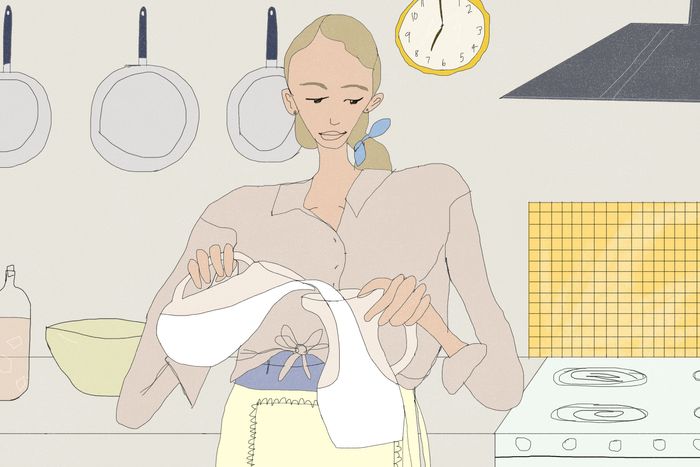
This article originally appeared in Brooding, a newsletter delivering deep thoughts on modern family life. Sign up here.
Gwen the Milkmaid creates fairly cookie-cutter tradwife content: bed-making and bowl-stirring while barefoot in a floral dress, abundant sourdough, male dominion over women, and urgent warnings that the government is trying to disrupt the sanctity of the white hetero nuclear family.
She works in a genre that seems to be growing, although it’s very hard to say for sure, given how our algorithms work. Unlike other creators in this genre, she used to be a popular bisexual vegan ASMRtist and OnlyFans creator, posting under the name GwenGwiz. It would appear that once she started making serious money on OF, she moved to the suburbs (or exurbs — opinions vary) and, as she frequently professes, got interested in submitting to the will of a man.
Gwen the Milkmaid’s transformation is an example of what’s known as the “crunchy-to-alt-right pipeline.” The ideological coziness between far-left anti-vaxxers and alt-right white supremacists is, at this point, well documented. But it continues to bewilder and upset audiences who can’t always parse the ideology behind the appealing aesthetics. You might come for the calming visuals of someone kneading sourdough and pouring milk from one big glass container into another big glass container (they love doing this) without realizing that you’re actually consuming covertly white-nationalist content.
Many tradwife creators like Gwen the Milkmaid have enthusiastically enlisted in the culture wars, baiting and being baited by feminists both real and imagined. Tradwife content is a game of chicken with women like me: Do I turn away and pretend I don’t see it? Or do I wade into the comments and call her a victim of oppression?
I’m not totally convinced that trad wives pose any real threat to women or to feminism. For a while, I suspected there was something closed-system about tradwife influencers, that they require an outraged audience to keep trending, and if we ignore them — deprive them of oxygen — they might fizzle out. There’s the obvious issue of the overwhelming whiteness, but as Tressie McMillan Cottom put it in her recent essay about race, gender, and Bama Rush, “Why would anyone want to integrate that?” These white women can keep their tradlives. But I am beginning to wonder if tradwife aesthetics are coalescing into an ideological shorthand that might actually have consequential staying power, even after many of these aspiring tradwife influencers themselves move onto other things.
Tradlife looks very different depending on which app you’re using. Tradwife content on Elon Musk’s platform is mostly for and by men, which means it’s fundamentally constitutive of little more than a circle jerk. It’s indecent to look at it, let alone engage with it.
On TikTok, a lot of the tradwife content is made by young women like Gwen the Milkmaid — so young, in fact, that many of them don’t have kids yet. TikTok tradwifery is a bit boring to watch. They often seem, as one commentator put it, like Sims. The performance is so exaggerated that it doesn’t land as fully sincere, which makes it hard to get mad at. The interiors, meanwhile, are more exurban new construction than scenic subsistence farm. These young ladies are warning us about the toxins in vaccines and plastics from rooms made with building materials whose off-gasses I can smell through my phone screen. I was young once too, and playing pretend like you’re in Little House on the Prairie can be fun. But ultimately, you put on your puffer coat and head out to Target for your tampons and Nespresso pods like everyone else. This is just a hunch, but I suspect many of the tradwives of TikTok are going through a phase, and if we look in on them in five years, they will have moved on.
TikTok tradwives go much harder on the ideology and on the smutty side — the overwrought Christian hashtags, the fetish dresses and cinched aprons, the milky-white cleavage — while actually showing us much less of the life itself. The showing happens on Instagram, where ideology is concealed behind lush gardens, cherubic baby-fat rolls, and actual homestead kitchens. What Instagram lacks in buxom bosoms and hashtags it more than makes up for with perfect evening light and natural blonde hair. The ur-tradwife of Instagram is, of course, Ballerina Farm’s Hannah Neeleman, who was very recently crowned the new Mrs. American. (Mrs. American is, as far as I can tell, the subordinate sister pageant to Mrs. America, which is Miss America for married women.) She’s been written about extensively, so I’ll be brief.
Hannah is an icon for aspiring tradwives, but, like Gwyneth in the wellness space, she occupies a logistically and energetically unattainable tier. Both women have some kind of spiritual Red Bull coursing through their veins, matched with unlimited funds. She is married to the son of the founder of JetBlue, which explains the bottomless farm budget. She is Mormon, which explains the number of children (seven). She went to Juilliard, which explains the dancing. There isn’t really much mystery here. I’m sure she has a small army of young Mormon babysitters who help with the kids. There is abundant child care in Mormon Utah; it’s part of the culture.
What is irksome about Instagram tradlife isn’t the question of “How does she do it all?” It’s that the visual appeal overrides whatever ideology lives in the background — and that’s the point. When Hannah Neeleman engages with chic rich-hippie brands like Rudy Jude and DÔEN on Instagram, she’s deliberately blurring the line between aesthetics and ideology. It’s in her best interest as a creator to cast a net wide enough to contain progressive homesteaders as well as the Quiverfull set, and she’s very good at this.
Homesteading and hand-making as practices are by no means inherently conservative. Beth Gantz, a homesteader in mid-Michigan who creates content about her farm life, doesn’t feel kinship with tradwives at all. (Gantz created a now-viral Reel interrogating the underpinnings of tradwife content recently.) Gantz’s content is visibly tethered to reality in one way that tradwife content usually isn’t: She occasionally includes her husband in posts, which many tradwives conspicuously refrain from doing, making one wonder if there are men in the picture at all.
“A lot of these homesteading skills are actually rooted in people who were in poverty,” she told me recently. “People turned to these things out of necessity. To do things in the most expensive and beautiful way possible just feels super icky to me. And if you think about it politically, a lot of conservative values don’t align with the things I associate with homesteading — stewardship of the earth, taking care of people who are less fortunate than you.” Those, to Gantz, are the pillars of homesteading, rather than the hyperindividualistic mentality you see in tradwife content.
But once we’ve accounted for the ideological slipperiness of this content, is the tradwife’s “aestheticization of care” a problem we should be worried about? You could argue that by prettifying care, tradwives obscure how exhausting it really is and reinforce outdated gender norms around who does what kind of work. But honestly? Women have been trying to make care work cute since forever. We were making it cute for the fun of it, and to help cope with the work itself, and as art. Making it cute is not the problem. Would it be better if we were all on the commune eating lentils and wearing matching oil-stained Stalinist jumpsuits? I’ve lived on a commune, and I can promise everyone yearns for some cute when it’s stripped away.
What does concern me about tradwife content is the way it breathes new life into the old “mommy wars.” The mommy-wars concept first appeared in Child magazine in the ’80s, playing off social anxiety about the increasing number of mothers joining the workforce. According to the logic of the mommy wars, women who stay at home to raise their families are the natural enemies of women who leave for work. It’s unclear to what extent these two “sides” were adversaries to begin with, but the media narrative stuck, and the concept has been riffed on continuously ever since.
Neha Ruch, founder of Mother Untitled, a group that works to redefine ideas around stay-at-home motherhood and maternal ambition, told me that she thought tradwife discourse is partly an anxiety response to the way norms around care work have shifted in the wake of COVID-19. “The danger is that we are in a moment where household labor is being rethought. COVID had that impact of pulling the curtains back on invisible labor, and we are at a fragile point. Progress is being made, and real change is possible” — but, to her eyes, the popularity of tradwife content risks undermining that progress.
“We do not want to go back to the mommy wars,” said Ruch. “That was created by the media and it pitted women against each other. We’re seeing the exact same dynamic today.”
The mommy wars are one of those stories with an eternal half-life. Tradwife content, aggressively opposed to working outside the home, might share some of those sticky qualities. What if tradwife aesthetics were already well on their way to becoming an ideological shorthand, a set of visual cues with the capacity to immediately summon emotional responses from both the left and the right? Wouldn’t that be irresistible, especially, say, in a not-too-distant election cycle? What if the next Pepe the Frog were an animated tradwife? What if tradwife symbolism became a rallying cry for an entire generation of alienated young people? When I really started to spiral, I decided to call up Max Read for some longer-term internet-trend perspective.
Read writes the Read Max newsletter and has been a longtime journalist on the social-media-discourse beat. I asked him if he believes that tradwife content is mostly bait or mostly authentic. He says it’s neither — it’s just audience strategy. “Social networks are specifically designed to engage people in exactly this way: through the performance of political and social identity. Putting that together as a lifestyle that you show over the course of multiple videos? It’s perfect.”
What about the impressionable young women at risk of being radicalized by the seductive crucible of unpasteurized dairy and skepticism about the value of a public-education system? Who will speak for them, I pleaded.
“This is strictly observational, but my guess is that the people who are driving the circulation of this stuff are men,” said Read. “Maybe it’s a different version of the e-girl phenomenon or the OnlyFans phenomenon. To the extent that I would worry about anything in the future, instead of creating a mass of tradwife women, it feels a lot like you’ll get one or two very famous ones, and a mass of simping male followers.”
I hope that Read is right and that the largely female corps of commenters in the tradwife space are just the small tip of the audience iceberg, and below the surface lies a legion of simps. Sounds extremely dorky, but manageable.
More From This Newsletter
- What Motherhood Looks Like in ‘Florida!!!’
- Parenting Through Our Control Issues
- When Kids Are Addicted to their Phones, Who Is to Blame?





